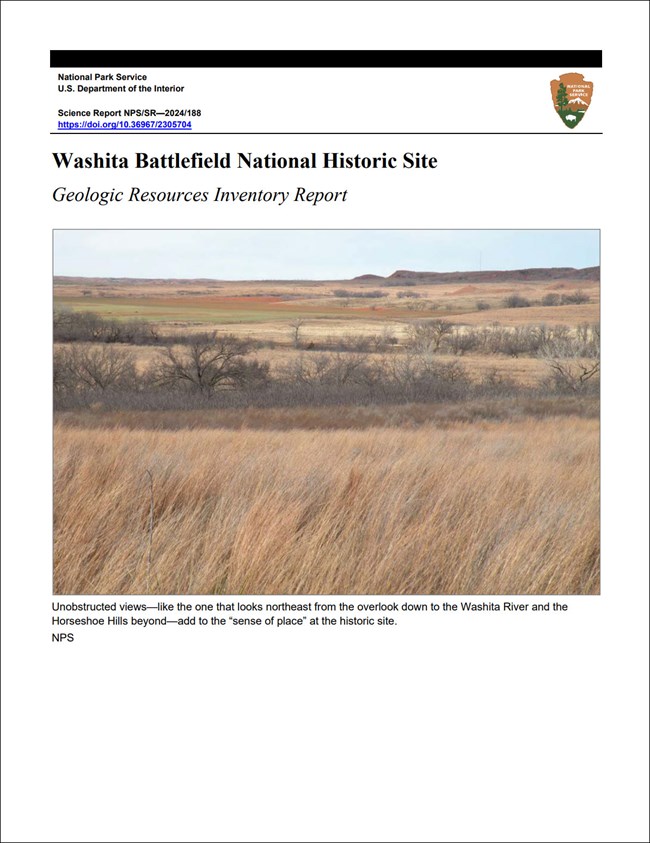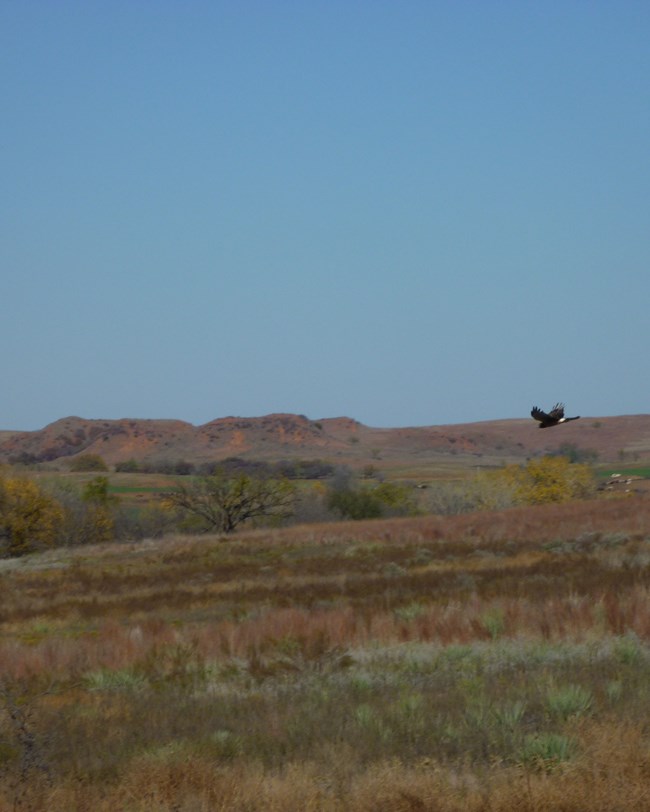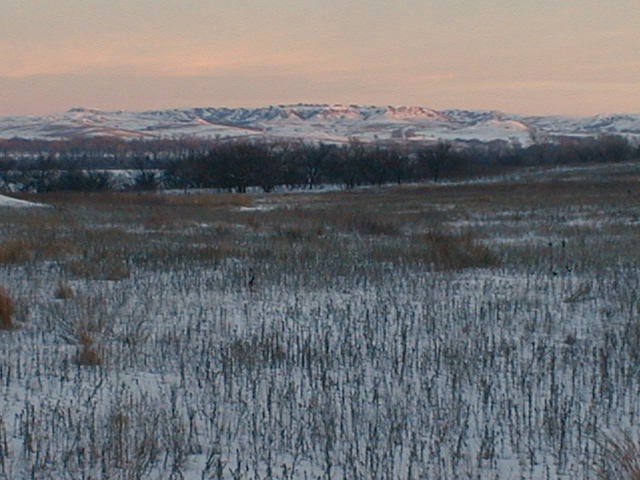Last updated: January 14, 2025
Article
NPS Geodiversity Atlas—Washita Battlefield National Historic Site, Oklahoma
Geodiversity refers to the full variety of natural geologic (rocks, minerals, sediments, fossils, landforms, and physical processes) and soil resources and processes that occur in the park. A product of the Geologic Resources Inventory, the NPS Geodiversity Atlas delivers information in support of education, Geoconservation, and integrated management of living (biotic) and non-living (abiotic) components of the ecosystem.

Introduction
Washita Battlefield National Historic Site (NHS) commemorates the site of the Southern Cheyenne village of Peace Chief Black Kettle, which was attacked just before dawn on November 27, 1868 by the 7th U.S. Cavalry under the command of Lieutenant Colonel George A. Custer. Black Kettle’s winter camp was located on the floodplain of the Washita River, a perennial, meandering stream that formed a series of horseshoe bends in the area. The location of Black Kettle’s camp had apparently been selected to offer some protection from the winter winds prevalent on the Great Plains, but the low-lying location became a deadly trap after the attack started. The cavalry used the area’s geography to their advantage in other ways; for example, by using topographic highs for lookouts such as “Custer’s knoll,” also the starting place of the attack, and using ridgelines to effectively encircle Black Kettle’s camp.
Washita Battlefield NHS is 326 acres in size and is located in Roger Mills County in west-central Oklahoma, about a mile northwest of the town of Cheyenne. Parcels of the Black Kettle National Grasslands surround the historic site. The park contains the focus area of the conflict, including Black Kettle’s camp, the site where Black Kettle and his wife were killed, and the pony kill site where the cavalry slaughtered an estimated 650 Cheyenne horses. Areas covered by U.S. Cavalry military maneuvers are both within and outside park boundaries.

Washita River floodplain and Quaternary terrace and eolian deposits are at the surface of most of Washita Battlefield NHS. The Cloud Chief Formation and Doxey Formation, both bedrock units of Permian age, have been mapped at the surface in some upland areas, but are poorly exposed.
In the Washita area, the Cloud Chief Formation consists of red-brown and greenish-gray shale and siltstone with gypsum beds, especially near the base. In central Roger Mills County, it is approximately 190 ft (58 m) thick. The Cloud Chief Formation was deposited in an arid coastal environment including shallow marine, tidal, mud flat (including a sabka enviornment) and fluvial depositional environments during the late Permian between about 262 and 255 million years ago. The Cloud Chief is overlain by the Doxey Formation. The contact between the two formations is gradational, but the Doxey is darker in color. The Doxey Formation is exposed in higher elevations within the historic site and on knolls and bluffs surrounding it. The Doxey Formation was deposited in a subaqueous environment such as a coastal mudflat.
Quaternary deposits in the historic site include modern Washita River floodplain sediments that are mostly fine grained, older terrace deposits that include coarser grained material such as pebbles and gravel, and paleodunes (eolian deposits).
Geologic Setting

NPS photo.
Washita Battlefield NHS lies in the Anadarko Basin geologic province. The Anadarko Basin is the deepest sedimentary and structural basin in the interior of the United States. It covers approximately 50,000 square miles (130,000 square km) and contains over 40,000 ft (12,190 m) of sedimentary rocks that are Cambrian to Permian in age. The Anadarko Basin extends from western Oklahoma, across the Texas Panhandle and into southwestern Kansas and southeastern Colorado. The basin also contains one of the most significant natural gas deposits in the country as well as important helium reserves.
The historic site is in the Western Red-Bed Plains geomorphic province, which consists of gently rolling hills of nearly flat-lying Permian red sandstone and shale. The High Plains geomorphic province, largely a flat upland surface on Tertiary and Pleistocene alluvial and windblown sands that is dissected by rivers and major streams, is to the west of Washita Battlefield.
Related Links
Washita River
Approximately a one-mile (1.6 km) stretch of the Washita River runs from west to east across the historic site. Sergeant Major Creek, which was also of historic significance, is located just downstream. Washita Battlefield NHS is located within the Sergeant Major Creek subdrainage of the Washita Headwaters watershed, which encompasses approximately 750 square miles. The Washita Headwaters watershed is rural in character, consisting primarily of rangeland and irrigated agriculture in suitable areas, and is subject to long-term and short-term droughts. The headwaters of the Washita River are in the northeastern part of the Texas Panhandle about 50 mi km (80 km) upstream of the historic site.
The landscape surrounding Washita Battlefield was drastically affected by the Dust Bowl in the 1930s, which caused changes to the local ecosystems, particularly soil health and local hydrology. The Dust Bowl may also have contributed to stream characteristics that are discordant with its watershed conditions. Currently, the Washita River is considered an undersized stream with a wide valley-bottom floodplain. Flood control dams and groundwater withdrawals for irrigation may also impact current stream characteristics. Under present conditions, the river channel is sometimes dry.
The Washita watershed contains some of the oldest upstream flood control dams in the nation, with more than 70 dams that are mostly between 35 and 60 years old located along the river and its tributaries above Washita Battlefield NHS. Long-term flow records (1937 – present) indicate that these structures have greatly reduced flooding and significantly modified natural flow patterns on this reach of the Washita River from at least the early 1960s.
The present-day Washita River in Washita Battlefield NHS is surprisingly close to the channel that existed in 1868 when Black Kettle located his winter camp on the floodplain. The site was close to a water supply sufficient for the tribe and its horses, and the riparian zone was enclosed by a canopy of cottonwood trees that would have provided shelter and firewood.
The morphology of the Washita River, both in 1868 and at the present, is that of a single-thread, sinuous, sand-bed channel. But the river’s hydrology is different and the channel has migrated, potentially across the site of Black Kettle’s camp, which is now on the north side of the river.
There are three terrace levels above the present-day floodplain at Washita Battlefield NHS. These terrace deposits are at the surface in most of the rest of the site beyond the current floodplain. The highest and oldest terrace level is situated 20-23 ft m (6-7) above the riverbed, and the youngest terrace level is 8-10 ft (2.5-3 m) above the riverbed.
Groundwater at Washita Battlefield NHS is hard and may contain excessive dissolved solids and is a local alluvial aquifer located along the river.
Related Links
Paleontological Resources
No fossils have been found in Washita Battlefield NHS. Fossils are rare in the Doxey and Cloud Chief formations, although marine invertebrates have been reported in the Cloud Chief Formation just outside the park boundary. Fossils have also not been found in the Quaternary sediments.
All NPS fossil resources are protected under the Paleontological Resources Preservation Act of 2009 (Public Law 111-11, Title VI, Subtitle D; 16 U.S.C. §§ 470aaa - 470aaa-11).
Geohazards
Natural geologic processes continue to occur in and around Washita Battlefield NHS on time scales ranging from seconds to years. Visitors should be cautious and alert to geohazards that may be present. Flooding may present a potential hazard along the Washita River, but since the Washita River is controlled by a series of dams it is not a serious issue.
Western Oklahoma has a relatively low seismic hazard. The USGS 2014 Seismic Hazard Map indicates that the Washita Battlefield area has a 2% chance that an earthquake peak ground acceleration of between 6 and 10 %g (percent of gravity) being exceeded in 50 years due to natural earthquakes. Peak ground acceleration between 6 and 10 %g is roughly equivalent to III on the Modified Mercalli Intensity Scale. The expected number of damaging earthquake shaking in the Texas Panhandle in 10,000 years is between 4 and 10.
In the last decade or so, Oklahoma has experienced a dramatic increase in earthquakes. These earthquakes are thought to have been induced by injection of wastewater from oil and gas production in deep wells. The area with induced earthquakes is east of Washita Battlefield NHS, and the historic site’s seismic hazard should reflect only that from natural earthquakes.
Related Links
Cave and Karst
No caves are known within Washita Battlefield NHS, but the area contains collapse structures related to salt karst. Bedded salt in Permian units is widespread in the subsurface of the Anadarko Basin in western Oklahoma. Local dissolution of salt at shallow depths by groundwater has caused subsidence or collapse of overlying strata.
In and around Washita Battlefield, peculiar conical hills appear to be small-diameter breccia pipes or collapse features that are composed of blocks of the Doxey Formation that are at the stratigraphic position of the underlying Cloud Chief Formation. These hills have collapsed beds, slump blocks, and isolated boulders that suggest a collapse origin. The breccia pipes have formed topographic highs because the Doxey Formation is more resistant to erosion than the friable Cloud Chief Formation.
Dissolution of gypsum beds to produce gypsum karst has also been proposed for areas in western Oklahoma. But most of the gypsum present in the Cloud Chief Formation and other units is thinly bedded, severely limiting the likelihood that gypsum dissolution is a significant factor in the development of collapse features in the area.
All NPS cave resources are protected under the Federal Cave Resources Protection Act of 1988 (FCRPA)(16 U.S.C. § 4301 et seq.).
Related Links
Other Geologic Resources and Issues
Agriculture, tilling, fence construction, and other modifications have impacted the land surface of Washita Battlefield NHS. The Panhandle and Santa Fe Railroad constructed a line across the site in 1928–1929, altering the natural hydrology of the site by acting as a dam or constriction to local drainages. The site’s General Management Plan proposes to remove the railroad bed, restoring a portion to the original grade and using other sections as part of the trail system.
Regional Geology
Washita Battlefield National Historic Site is a part of the Central Lowlannd Physiographic Province and shares its geologic history and some characteristic geologic formations with a region that extends well beyond park boundaries.
Related Links
- Scoping summaries are records of scoping meetings where NPS staff and local geologists determined the park’s geologic mapping plan and what content should be included in the report.
- Digital geologic maps include files for viewing in GIS software, a guide to using the data, and a document with ancillary map information. Newer products also include data viewable in Google Earth and online map services.
- Reports use the maps to discuss the park’s setting and significance, notable geologic features and processes, geologic resource management issues, and geologic history.
- Posters are a static view of the GIS data in PDF format. Newer posters include aerial imagery or shaded relief and other park information. They are also included with the reports.
- Projects list basic information about the program and all products available for a park.
Source: NPS DataStore Saved Search 3194. To search for additional information, visit the NPS DataStore.
A NPS Soil Resources Inventory project has been completed for Washita Battlefield National Historic Site and can be found on the NPS Data Store.
Source: NPS DataStore Saved Search 3219. To search for additional information, visit the NPS DataStore.

Related Links
Related Articles
Washita Battlefield National Historic SiteNational Park Service Geodiversity Atlas
The servicewide Geodiversity Atlas provides information on geoheritage and geodiversity resources and values within the National Park System. This information supports science-based geoconservation and interpretation in the NPS, as well as STEM education in schools, museums, and field camps. The NPS Geologic Resources Division and many parks work with National and International geoconservation communities to ensure that NPS abiotic resources are managed using the highest standards and best practices available.

